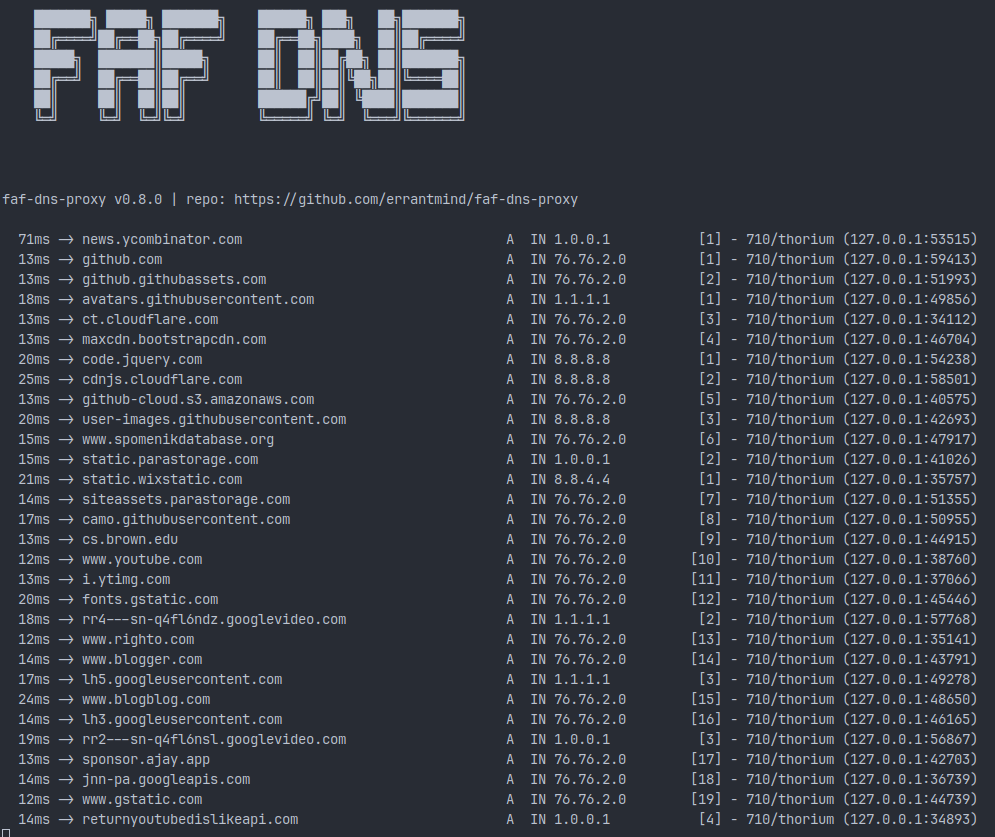FaF DNS Proxy is a cross-platform, encrypted DNS (DoT) proxy / forwarder written in Rust. It follows the general design philosophy of the FaF Web Server.
FaF has been tested on Linux, Mac (M1), and Windows, and may work on other platforms as well.
An example of the default (non-daemon) output, which gives some immediate insights into timings and upstream DNS resolver performance. This also demonstrates the 'client identification' feature which is optional as it adds about 10ms of latency:
- You want the fastest DNS resolution available because you notice it speeds up your web browsing experience, among other areas.
- You don't want your ISP spying on your DNS queries.
- You want something that 'just works' out-of-the-box, with the default configuration.
- Perhaps you noticed occasional, mysterious delays that add 2-10 seconds to some page loads when using some other resolvers with DoT / DoH.
- DNS filtering (e.g. adblock - disabled by default)
- Client identification - Identify which process are issuing what queries on your computer (linux only, disabled by default)
- Chart output to show the distribution of uncached dns query latencies (disabled by default)
- Full-duplex async design.
- Minimal parsing of DNS records to lower overhead.
- 'Shotgun' DNS queries to multiple upstream resolvers by default. The first reply wins.
- Caching of DNS answers (using the TTL on the answer), with optional minimum TTL override.
- TLS Session Caching (to avoid a full handshake when (re)connecting to upstream resolvers).
- Connection re-use.
- Automatic reconnections to DNS servers when connections are closed to ensure resolution doesn't wait on first establishing a connection.
- SNI disabled by default.
At a basic level:
- Your computer sends a DNS query (unencrypted) to FaF, which is running on your computer or another computer on your local network.
- FaF checks its cache to see if there is an unexpired entry.
- If it is in the cache, FaF returns the answer immediately.
- If it is not in the cache, FaF encrypts your request and sends it to (one or more) upstream DNS resolvers.
- Upon receiving a response from an upstream DNS resolver, FaF answers your device's original query.
You can run and use faf-dns-proxy locally, or deploy it somewhere and use it from there. I run it locally on each of my computers.
There is no configuration file as the defaults will serve most users well. If you want to add / edit the default upstream DNS providers, or the TTL override, make the necessary changes in the source file statics.rs.
- Clone this repository and build it using
cargo +nightly build --release. - Stop your existing DNS resolver. See the next section for an example.
- Run the binary with elevated privileges so it can listen on port 53 (DNS).
- Navigate to some websites to check and see if it is working. You should see resolution information for each website you visit your terminal. If you don't, you may need to disable your brower's built-in DNS proxying service. This is usually in your brower's network settings and may be called
DoHorDNS over HTTPS. - If it is working, disable your existing DNS resolver so it doesn't 'come back' (on reboot usually).
- If your linux distro uses systemd, check out the example service in this repo to enable it to run on boot. You'll probably want to copy the
faf-dns-proxybinary somewhere first.
If you have a problem, and suddenly realize you can't search the internet for answers anymore because your DNS is broken, just stop FaF and re-enable your previous DNS resolver.
- Follow the above steps. On step 2:
- Stop systemd-resolved with
sudo systemctl stop --now systemd-resolved.service. - Ensure your DNS resolution is pointed at FaF: Make a backup of
/etc/resolv.conf. Then make a new/etc/resolv.conf. If running FaF on your local computer, this should be the only thing in the file:
- Stop systemd-resolved with
nameserver 127.0.0.1
options no-check-names
- On step 5, disable systemd-resolved with
sudo systemctl disable --now systemd-resolved.service.
- Clone this repository and build it using
cargo +nightly build --release. - Open Powershell and run the newly built binary. It should not require elevated privileges, but you may need to run Powershell as administrator on some versions of Windows.
- Navigate to your system's network settings and change your system's primary DNS resolver to 127.0.0.1. Leave the 'alternative' empty.
- Browse some websites to check and see if it is working. You should see resolution information for each website you visit in the Powershell window. If you don't, you may need to disable your brower's built-in DNS proxying service. This is usually in your brower's network settings and may be called
DoHorDNS over HTTPS. - If it is working, you can script it to run at startup.
If you have a problem, and suddenly realize you can't search the internet for answers anymore because your DNS is broken, undo the changes to your system's DNS settings.
- By default, Firefox and some other browsers bypass the system's DNS, using their own built-in DoH. To reap the benefits of FaF while browsing, ensure this is disabled. This is usually somewhere in the browser's network settings.
- Only IPv4 upstream DNS resolvers are currently supported.
- Using the blocklist adds some delay as you might expect. In my tests the median overhead was about 10 microseconds locally.
Just look at proxy.rs, everything is either there or referenced there.
Contributions are welcome, but please discuss before submitting a pull request. If a discussion leads to a pull request, please reference the #issue in the pull request. Unsolicited pull requests will not be reviewed nor merged.
All code is licensed under AGPL 3.0 unless an individual source file specifies otherwise.

